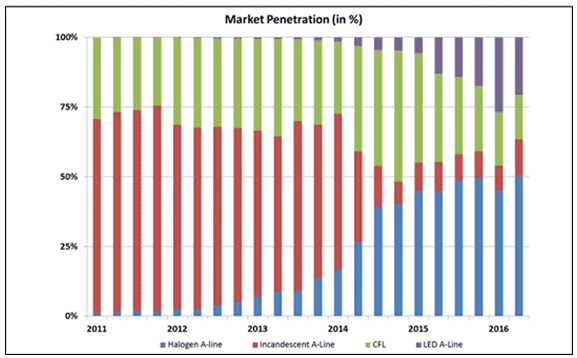Lighting Revolution Update
In the May 2016 ASAP newsletter, we reported on DOE’s historic proposed light bulb efficiency standards that would require adoption of very efficient (solid state, primarily LED) lighting technology by January 2020. The final rule, which should be out by the end of 2016. In the meantime, the lighting markets and technologies continue to evolve.
Savings Getting Even Bigger
DOE’s latest SSL forecast report now projects the following:
- By 2035, LED lamps and luminaires are anticipated to account for 86% of installed lighting stock across all categories (compared to only 6% in 2015).
- Annual savings from LED lighting will be 5.1 quads in 2035, nearly equivalent to the total annual energy consumed by 45 million U.S. homes today, and representing a 75% reduction in energy consumption versus a no-LED scenario.
- Most of the 5.1 quads of projected energy savings by 2035 is attributed to two commercial applications (linear and low/high-bay), one residential application (A-type), and one that crosses both sectors (directional). Lighting control technologies account for almost 2.3 quads of the total.
- From 2015 to 2035, a total cumulative energy savings of 62 quads – equivalent to nearly $630 billion in avoided energy costs – is possible if the DOE SSL Program goals for LED efficacy and connected lighting are achieved.
Market Swings
The National Electrical Manufacturers Association tracks quarterly US shipments of its member’s products, including incandescent, halogen, compact fluorescent and LED light bulbs. Starting in 2014, LED and halogen bulbs began taking market share from incandescent and compact fluorescent alternatives. Most recently (2nd Qtr 2016), NEMA shows LED market penetration retreating slightly. Both incandescent and halogen market share appear to be up slightly while the share going to CFLs continues to decline. A single quarter of data cannot tell us much about the future, but the following infographic from the NEMA press release illustrates the volatility of the lighting market. As the market for LEDs grows, the market for other types of lighting shrinks, and long-lived LEDs replace relatively short-lived incandescent and halogen bulbs.

LED Test Procedure
DOE posted a test procedure for LED general service lamps on July 1, 2016 that covers most of the critical criteria for light bulbs: efficiency (lumen output divided by input power), Light quality (color rendering index and correlated color temperature), power factor, lumen maintenance and power consumption in standby mode. This is similar to the CFL test procedure, but is missing an accelerated life, or “stress” test.
Product durability has been a well-documented problem over the commercial life of CFLs. The lighting industry has not been able to reach consensus on an accelerated life test for CFLs, and generally does not support the stress test developed by ENERGY STAR which is now also part of the DOE test procedure. LEDs promise a longer life, a lower cost per lumen-hour, but a higher cost per lamp. Whether or not LEDs deliver on this value proposition is entirely dependent on durability. Experience suggests that we will eventually need an accelerated life test to get durable LED light bulbs.
“Smart” LEDs Aren’t Necessarily Efficient
ASAP flagged standby energy consumption as being a potential problem in our comments on DOE’s general service lighing NOPR. A a new report from the International Energy Agency’s 4E Solid State Lighting Annex presents results of lab tests on “smart” LED bulbs available in both North America and in Europe. The report found that standby energy consumption (when the bulb is turned off) can actually be larger than when the bulb is in active mode (turned on). For example, a smart LED bulb used in the home may only be on for three hours per day. If it draws 9 watts it would consume almost 10 kilowatt hours per year in active mode. The report found a wide range of standby power consumptions, but the most wasteful smart LED’s consume more than 2 watts while turned off. Because light bulbs in homes are typically turned off for 21 hours each day, these smart LEDs could consume more than 15 kWh/yr in standby mode. Even if the “smart” functionality allows a reduction in the number of hours per year that the bulb is turned on, it would be impossible for this smart LED to save as much energy as a “dumb” LED bulb operated with a conventional light switch.

